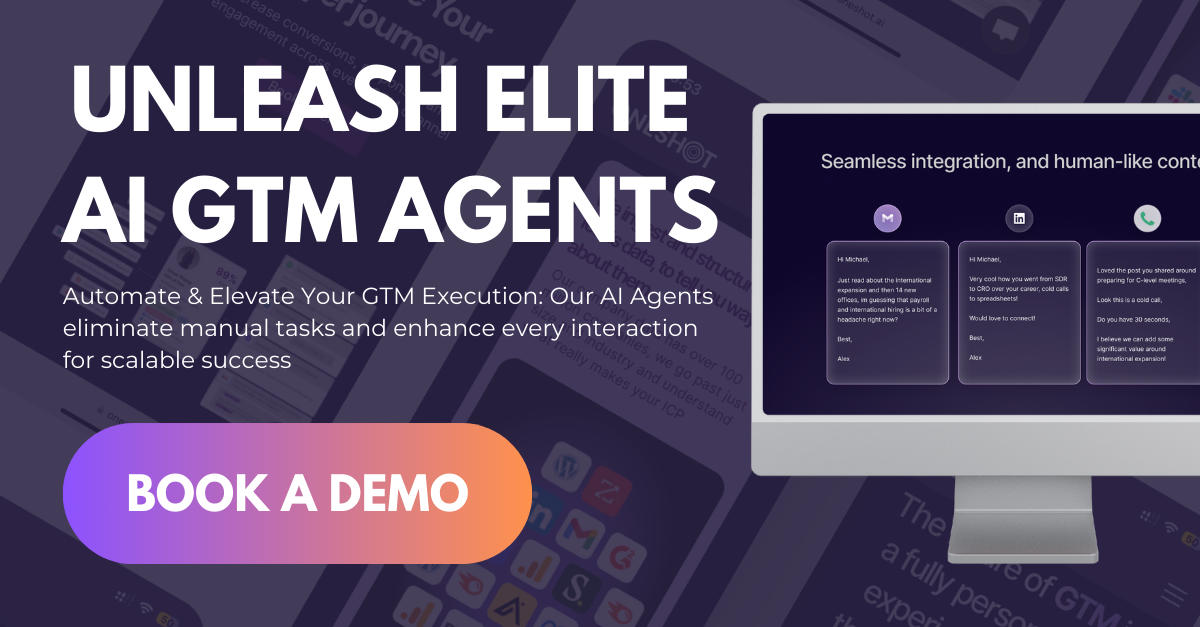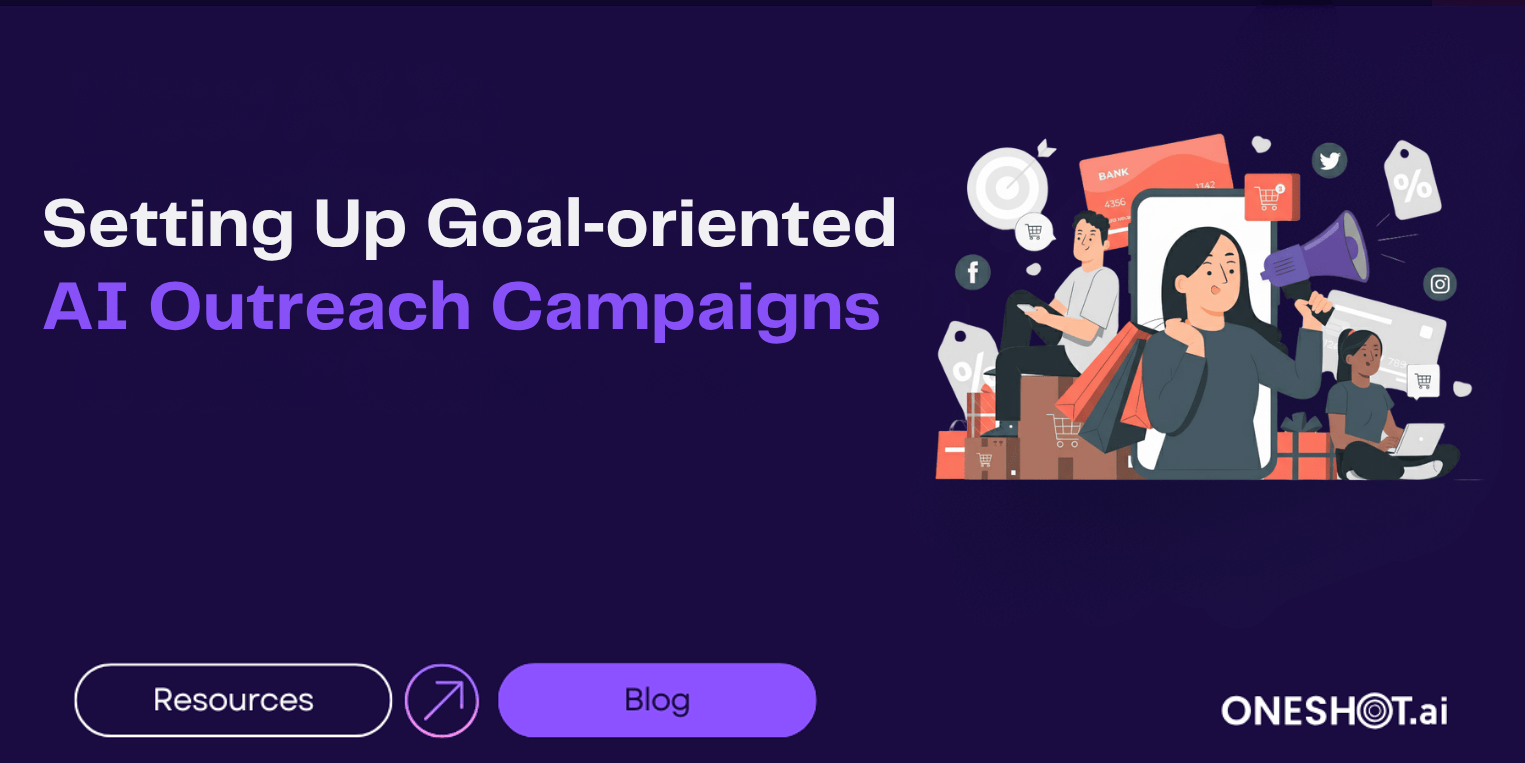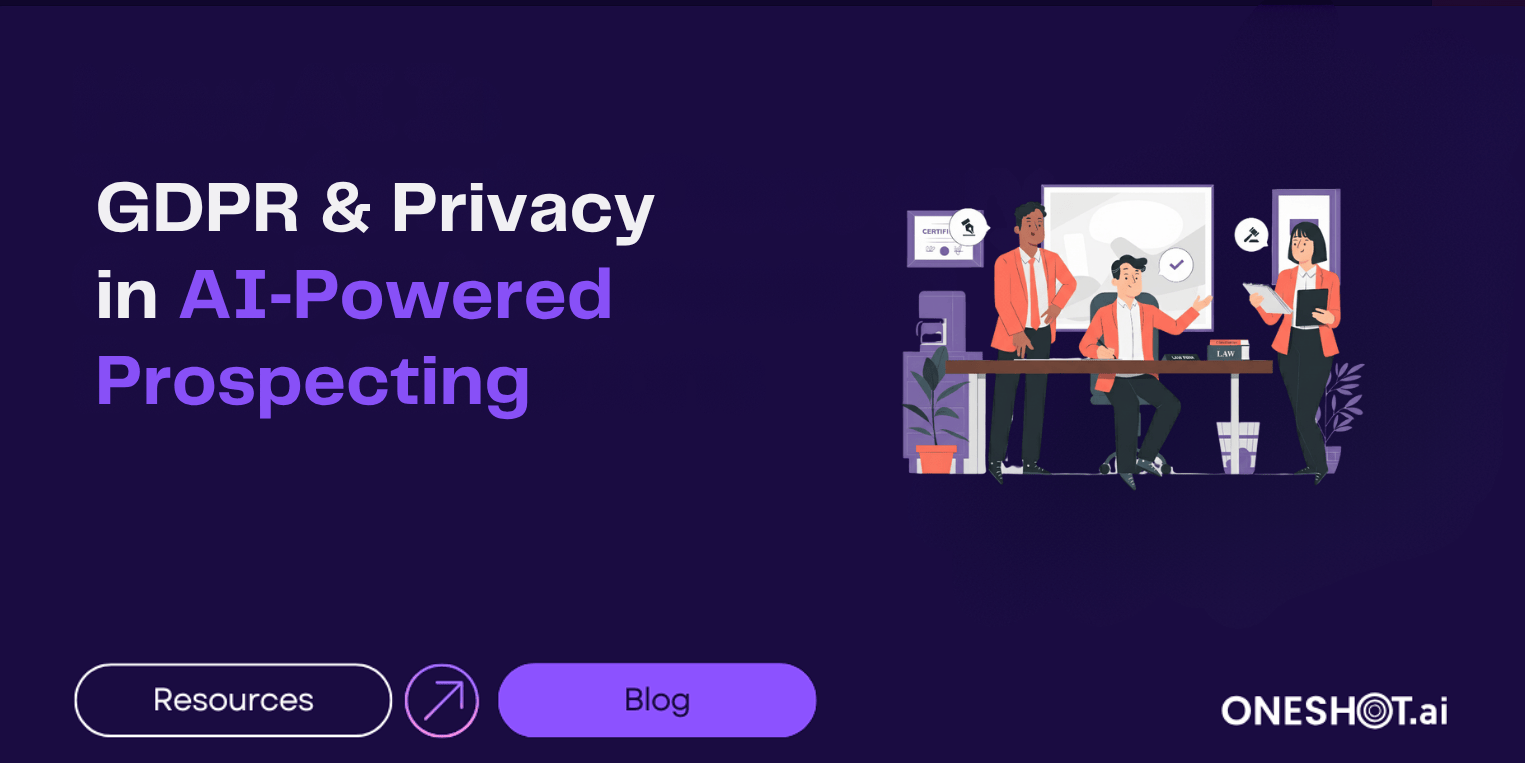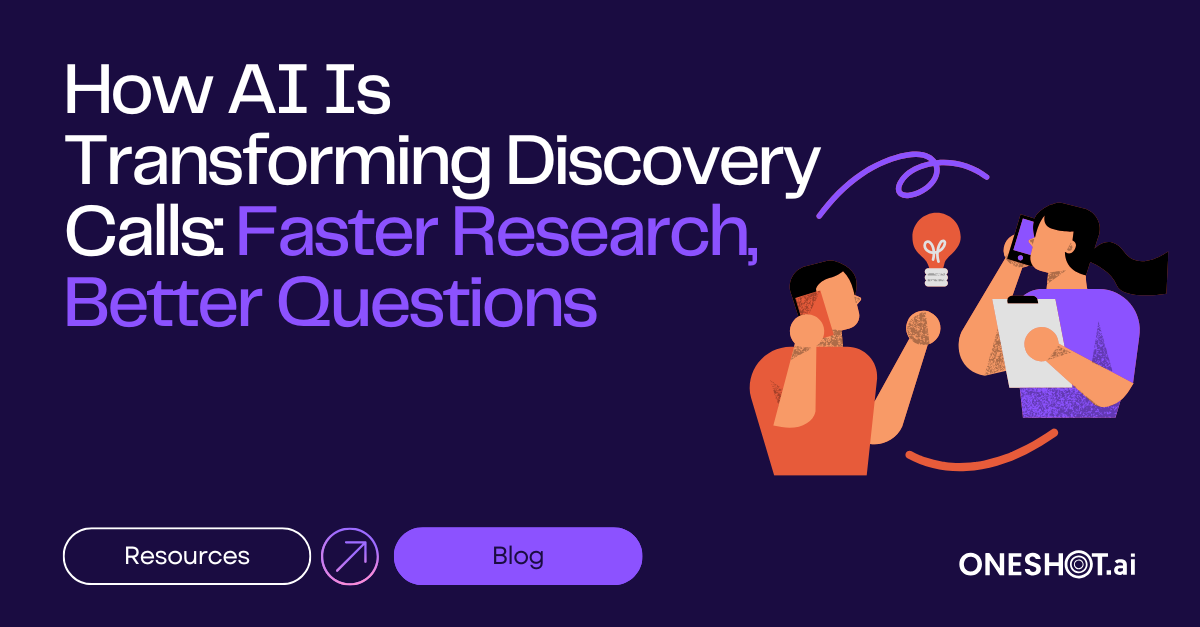In today’s B2B sales, a scattergun method of outreach simply doesn’t work. Buyers are hungry for relevance, context, and genuine connection – particularly in an era overwhelmed with generic email and cold messaging. That’s why goal-driven outreach campaigns are reshaping the way SDRs connect: each message is intended for a reason; every touchpoint generates a quantifiable result.
AI is at the heart of this transformation. Gone are the days of AI being only about automation. AI now assists in defining objectives, writing best-quality messaging, choosing appropriate cadence, and individualized outreach – at scale. It connects intent, data, and narrative in real time.
Step in OneShot.ai, a next-generation platform tailor-made for this era. With its agent modules- Insight, Persona, Personalization, and Scaling – OneShot.ai enables your team to define precise objectives, engage high-fit prospects, and provide context-driven engagement that converts.
Start your AI campaign today with AI-powered outreach using OneShot.ai.
What are Goal-Oriented Outreach Campaigns?
Goal-oriented outreach campaigns are outreach sequences that have a clear endpoint-whether that’s booking a discovery call, initiating an event registration, or re-engaging inactive accounts. Goal-oriented campaigns are a very precise measurement of action taken toward the established end goal, unlike mass outreach campaigns, which measure precious little else than numbers.
Key Differences: Generic Outreach vs. Goal-Oriented Campaigns
Systems for mass outreach are mostly broadcast in nature and are sent to large audiences with little customization. It's motivated by activity surface metrics such as sends or opens, tending to lead to low engagement and high fatigue.
In contrast, the goal-driven campaigns are designed deliberately according to buyer persona, intent signals, and deal stage, and aligned with SMART goals – Specific, Measurable, Achieved, Relevant, and Time-bound. These campaigns are regularly optimized through AI-powered signals such as reply intent and behavioural engagement.
The advantages are obvious: increased reply and conversion rates from well-timed, personalized messaging; improved targeting through the removal of low-fit or tired leads; and reduced customer acquisition cost (CAC) due to intentional, effective touchpoints.
With OneShot.ai, you define clear goals – such as "Book 10 discovery calls in 4 weeks" – and the platform harmonizes your persona messaging, cadence, channels, and follow-ups to produce results.
Use OneShot.ai to set up goal-based targeting at scale. → Define Your Campaign Goals
Setting Clear Outreach Goals
All successful SDR campaigns begin with a defined goal – and in AI-powered outreach, that goal needs to be even more concise. Typical objectives are to book discovery calls, qualify leads with AI-powered scoring, re-engage stale or inactive accounts, and promote future webinars or events.
To be successful, these goals need to adhere to the SMART framework. For instance: Book 15 Series B SaaS discovery calls (Specific), aiming for >10% response rate and 20% meeting conversion (Measurable), from present performance metrics (Achievable), as aligned with Q3 pipeline goals (Relevant), and done within 4 weeks (Time-bound).
Also crucial is alignment between Sales, Marketing, and RevOps. The different teams need to agree on the messaging pillars, the industries to target, and the volume at which they will carry out their outreach program, so there appears to be some level of integration or strategy for growth.
Example Goal Framework:
- Open rate > 40%
- Reply rate > 10%
- Meeting conversion > 25%
OneShot.ai's Persona Agent customizes messaging based on specific goals → See Persona Agent in Action.
Segmenting and Defining Buyer Personas
Why is Segmentation Useful?
A proper targeting mechanism separates “spray-and-pray” from strategic outreach. Firmographic data (industry, company size) separated from technographic data (tools used) and behavioural data (site visits, content downloads) serves to present the appropriate messaging at just the right moment to the right audience.
Dynamic AI-Driven Personas:
OneShot.ai’s Persona Agent automatically and implicitly crafts intelligent personas with great contextual relevance, from an amalgam of lead data, firmographics, and historical interactions. This intelligence builds hyper-relevant outreach.
Real-world example:
- A SaaS company divided its prospects into:
- VP of Product (mid-market SaaS)
- Head of Development (FinTech startups)
- Through custom AI-based personas, they achieved a 300% increase in meetings booked over eight weeks.
Use OneShot.ai to have precision-targeted personas generated on autopilot.

Building a Multi-Channel AI Outreach Strategy
In the SDR world today, using email alone is not enough. To effectively engage prospects and stand out from the noise, you must have a highly organized multi-channel outreach strategy.
Every channel is what you make of it and has its advantages and disadvantages: For example, email is trackable and scalable, but can suffer from degraded visibility as inboxes fill up.
Conversely, LinkedIn tends to provide a more intimate, context-driven experience but suffers from platform constraints. Cold calls provide a human element, but are time-consuming and tend to be imprecise.
SMS is extremely personal and direct, but should be used with caution to prevent compliance or deliverability problems.
Cadence is crucial in order to make this strategy work. An example 5-touch sequence may go as follows:
Day 0: Personal email
Day 2: LinkedIn invitation with a brief note
Day 4: Follow-up email with a good case study
Day 7: Phone call to add a personal voice
Day 10: Re-engage with an SMS message or LinkedIn message
AI of this kind plays a major role in this process. It therefore creates contextual alignment of the touchpoints with the OneShot.ai Personalization Agent, so that there is message continuity, right timing, and content according to the channel. This is how modern SDRs capture attention and carry on meaningful conversations.
Automate your multichannel strategy with OneShot.ai’s Scaling Agent. See It in Action
Using AI to Research and Personalize at Scale
AI increases outreach efficiency by substituting manual research with real-time data. Rather than spending hours sifting through LinkedIn, company websites, and news articles, SDRs can quickly access firmographics, recent news, and job changes – all surfaced automatically by OneShot.ai’s Insight Agent.
Each of your accounts is enriched with high-impact triggers such as funding announcements, executive hires, and strategic announcements that will help reps to strike when interest is at its peak.
In addition to these 'high-impact' events, behavioral data such as website visits or content downloads provide very relevant messaging opportunities - not just generic, token personalization.
Notice the contrast:
Before - "Hi [Name], hope you’re well."
After - "Hi [Name], saw your recent Series A announcement—congrats! Given your rapid growth, many teams I’ve spoken to are scaling SDR outreach with AI to meet demand."
The results? More meaningful opens, higher reply rates, and bigger trust—all driven by insight, not guesswork.
Try OneShot.ai's Insight + Personalization Agents working together → See Insight Agent.
Automation Without Losing Authenticity
To effectively reach out, AI shouldn’t sound robotic – getting the voice right is important. Using OneShot.ai's Persona Agent, you can set and adjust the tone called for in messaging across a spectrum from casual to corporate as appropriate to brand voice and intended persona. This way, you can ensure messaging always feels authentic, not automated.
With GPT-powered copy that has a personal touch, reps can create a solid first draft and then fine-tune it for voice, context, and relevance. Skip the generic – use actual milestones, company news, or recent interactions to make outreach stand out.
Do’s & Don’ts for Tone and Content in AI-Powered Outreach
To get AI-synthesized messaging to sound human and impactful, it is imperative to adhere to a couple of best practices. Do address by first names and add company-specific context to demonstrate real attention to detail.
Ensure that your messages are brief and conversational so prospects can read and respond easily. Where possible, mention common connections or timely news triggers to establish relevance and credibility.
On the other hand, don’t overrely on buzzwords and hyperbole – there is too much of it, and it makes messages sound generic and disingenuous. Don’t send prepackaged templates that disregard the recipient’s specific context.
Above all, don’t turn a blind eye to data. AI gets better with time by studying signals such as open rates, responses, and conversions. The more feedback it gets, the crisper and more relevant the messaging becomes.
Experience true-likeness personalization with OneShot.ai’s Persona Agent → Explore Persona Agent

Campaign Execution and Timing
Timing is as important as content. Let's include authoritative guidance:
HubSpot metrics tell us Tuesdays from 9 a.m. to 12 p.m. EST have the most engagement for B2B email, with 47.9% of marketers achieving best results within that timeframe
OptinMonster's 2025 wrap-up supports mid‑week mid‑mornings—Tuesdays and Thursdays from 9–11 a.m.—as sweet spots for engagement.
Best Practices:
- Send campaigns on Tues–Thurs, 9–11 a.m.
- Use AI tools to adjust to recipient time zones
- Warm up recipients to ensure deliverability
- Run in coordinated waves—test group, followed by larger rollout
- Regularly check responses and open rates, and have AI tweak cadence, messaging, and segment on the basis of real-time feedback.
OneShot.ai makes it easy to run and adjust campaigns in real time.
Measuring Campaign Success
To quantify the actual effect of your outreach, it's necessary to monitor essential performance metrics such as open rates, response/reply rates, meeting schedules, and conversion to opportunity or close-won.
These are the building blocks, though. AI-driven platforms like OneShot.ai go the extra mile by providing rich, actionable insights. Utilizing AI, the tool can auto-detect which messages work for which prospect and suggest improvements for additional variations, such as subject-line edits or best send times, and execute dynamic A/B testing so that high-performing variants are surfaced in real time.
Frictionless CRM integrations, e.g., HubSpot, Salesloft, Apollo, etc., maintain syncing of campaign metrics at any time on dashboards to ease performance tracking.
OneShot.ai auto-syncs metrics and campaigns with your sales stack → View Integrations.
Conclusion
AI outreach that is goal-oriented is the future of sales development for effectiveness. With measurable goals, defined smart personas, and AI-enabled personalization to improve multi-channel outreach, SDRs can achieve better engagement, more conversations, and faster conversions.
OneShot.ai makes your outreach easier—with modular agents, integrations across 200+ tools, and real-time metrics to drive every outreach campaign.
When you're ready to scale with intelligence? Try OneShot.ai — Book a 1:1 personal demo.
FAQ
Q: What is goal-based AI outreach?
Outreach with a particular outcome (meeting, qualification, re-engagement) optimized with AI for sequencing, personalization, and timing.
Q: How do I personalize outreach at scale?
Leverage AI models that create context-attentive, persona-tailored messaging off account insights, intent signals, and historical interactions.
Q: What metrics matter in a sales outreach campaign?
Top metrics are open rates, reply rates, booked meetings, and opportunity conversions – ideally seen through AI dashboards that suggest next steps.
Q: In what way is OneShot.ai unique compared to other tools?
It provides modular agents for Insight, Persona creation, Personalization, and Scaling, specifically designed to address clear, goal-oriented outreach requirements.
Q: Am I able to integrate my CRM with OneShot.ai?
Yes- OneShot.ai bi-directionally integrates with platforms such as HubSpot, Salesloft, and Apollo, allowing you to easily sync workflow and data.







